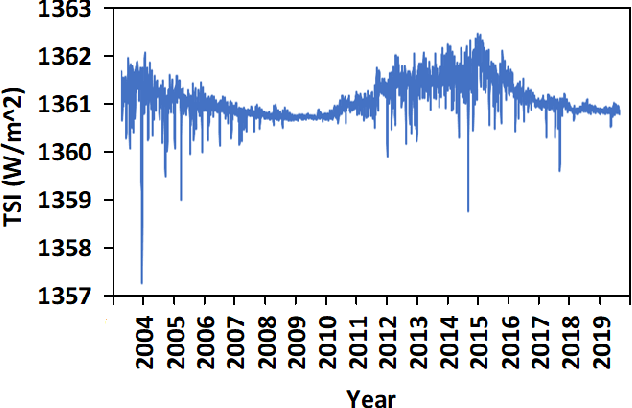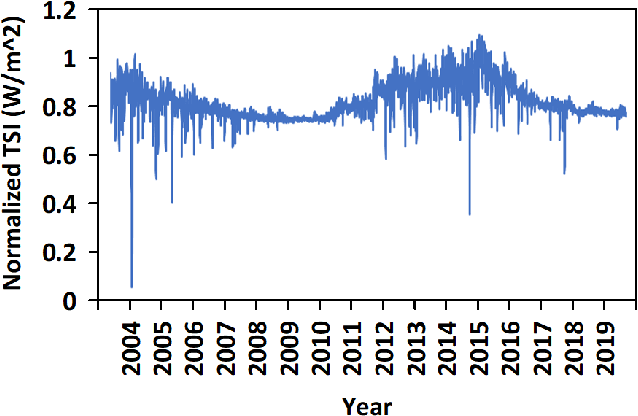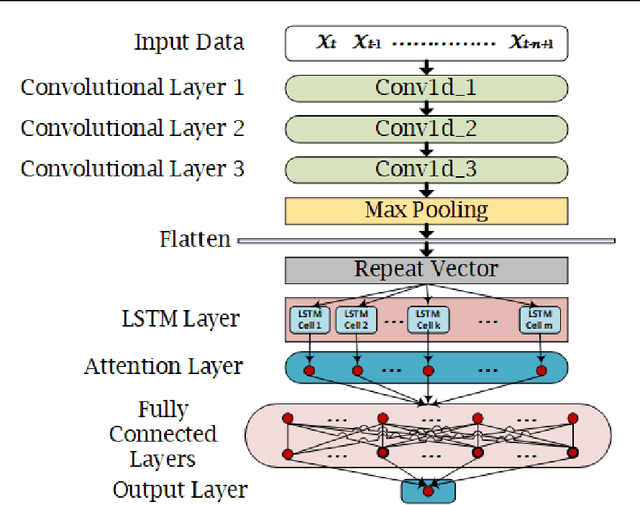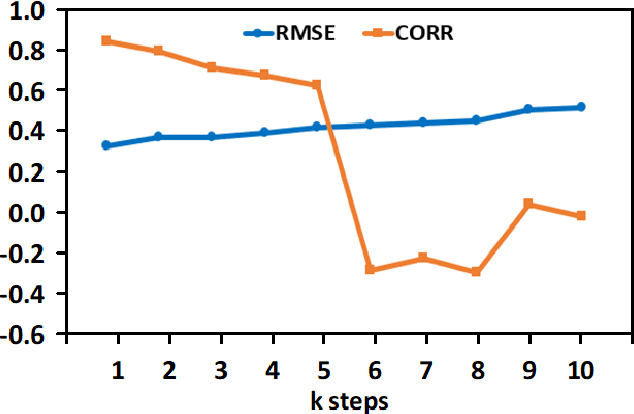Yasser Abduallah
Improving the Temporal Resolution of SOHO/MDI Magnetograms of Solar Active Regions Using a Deep Generative Model
Mar 05, 2025



Abstract:We present a novel deep generative model, named GenMDI, to improve the temporal resolution of line-of-sight (LOS) magnetograms of solar active regions (ARs) collected by the Michelson Doppler Imager (MDI) on board the Solar and Heliospheric Observatory (SOHO). Unlike previous studies that focus primarily on spatial super-resolution of MDI magnetograms, our approach can perform temporal super-resolution, which generates and inserts synthetic data between observed MDI magnetograms, thus providing finer temporal structure and enhanced details in the LOS data. The GenMDI model employs a conditional diffusion process, which synthesizes images by considering both preceding and subsequent magnetograms, ensuring that the generated images are not only of high-quality, but also temporally coherent with the surrounding data. Experimental results show that the GenMDI model performs better than the traditional linear interpolation method, especially in ARs with dynamic evolution in magnetic fields.
Prediction of Halo Coronal Mass Ejections Using SDO/HMI Vector Magnetic Data Products and a Transformer Model
Mar 05, 2025Abstract:We present a transformer model, named DeepHalo, to predict the occurrence of halo coronal mass ejections (CMEs). Our model takes as input an active region (AR) and a profile, where the profile contains a time series of data samples in the AR that are collected 24 hours before the beginning of a day, and predicts whether the AR would produce a halo CME during that day. Each data sample contains physical parameters, or features, derived from photospheric vector magnetic field data taken by the Helioseismic and Magnetic Imager (HMI) on board the Solar Dynamics Observatory (SDO). We survey and match CME events in the Space Weather Database Of Notification, Knowledge, Information (DONKI) and Large Angle and Spectrometric Coronagraph (LASCO) CME Catalog, and compile a list of CMEs including halo CMEs and non-halo CMEs associated with ARs in the period between November 2010 and August 2023. We use the information gathered above to build the labels (positive versus negative) of the data samples and profiles at hand, where the labels are needed for machine learning. Experimental results show that DeepHalo with a true skill statistics (TSS) score of 0.907 outperforms a closely related long short-term memory network with a TSS score of 0.821. To our knowledge, this is the first time that the transformer model has been used for halo CME prediction.
Prediction of Geoeffective CMEs Using SOHO Images and Deep Learning
Jan 02, 2025Abstract:The application of machine learning to the study of coronal mass ejections (CMEs) and their impacts on Earth has seen significant growth recently. Understanding and forecasting CME geoeffectiveness is crucial for protecting infrastructure in space and ensuring the resilience of technological systems on Earth. Here we present GeoCME, a deep-learning framework designed to predict, deterministically or probabilistically, whether a CME event that arrives at Earth will cause a geomagnetic storm. A geomagnetic storm is defined as a disturbance of the Earth's magnetosphere during which the minimum Dst index value is less than -50 nT. GeoCME is trained on observations from the instruments including LASCO C2, EIT and MDI on board the Solar and Heliospheric Observatory (SOHO), focusing on a dataset that includes 136 halo/partial halo CMEs in Solar Cycle 23. Using ensemble and transfer learning techniques, GeoCME is capable of extracting features hidden in the SOHO observations and making predictions based on the learned features. Our experimental results demonstrate the good performance of GeoCME, achieving a Matthew's correlation coefficient of 0.807 and a true skill statistics score of 0.714 when the tool is used as a deterministic prediction model. When the tool is used as a probabilistic forecasting model, it achieves a Brier score of 0.094 and a Brier skill score of 0.493. These results are promising, showing that the proposed GeoCME can help enhance our understanding of CME-triggered solar-terrestrial interactions.
Super-Resolution of SOHO/MDI Magnetograms of Solar Active Regions Using SDO/HMI Data and an Attention-Aided Convolutional Neural Network
Mar 27, 2024Abstract:Image super-resolution has been an important subject in image processing and recognition. Here, we present an attention-aided convolutional neural network (CNN) for solar image super-resolution. Our method, named SolarCNN, aims to enhance the quality of line-of-sight (LOS) magnetograms of solar active regions (ARs) collected by the Michelson Doppler Imager (MDI) on board the Solar and Heliospheric Observatory (SOHO). The ground-truth labels used for training SolarCNN are the LOS magnetograms collected by the Helioseismic and Magnetic Imager (HMI) on board the Solar Dynamics Observatory (SDO). Solar ARs consist of strong magnetic fields in which magnetic energy can suddenly be released to produce extreme space weather events, such as solar flares, coronal mass ejections, and solar energetic particles. SOHO/MDI covers Solar Cycle 23, which is stronger with more eruptive events than Cycle 24. Enhanced SOHO/MDI magnetograms allow for better understanding and forecasting of violent events of space weather. Experimental results show that SolarCNN improves the quality of SOHO/MDI magnetograms in terms of the structural similarity index measure (SSIM), Pearson's correlation coefficient (PCC), and the peak signal-to-noise ratio (PSNR).
Prediction of the SYM-H Index Using a Bayesian Deep Learning Method with Uncertainty Quantification
Feb 27, 2024Abstract:We propose a novel deep learning framework, named SYMHnet, which employs a graph neural network and a bidirectional long short-term memory network to cooperatively learn patterns from solar wind and interplanetary magnetic field parameters for short-term forecasts of the SYM-H index based on 1-minute and 5-minute resolution data. SYMHnet takes, as input, the time series of the parameters' values provided by NASA's Space Science Data Coordinated Archive and predicts, as output, the SYM-H index value at time point t + w hours for a given time point t where w is 1 or 2. By incorporating Bayesian inference into the learning framework, SYMHnet can quantify both aleatoric (data) uncertainty and epistemic (model) uncertainty when predicting future SYM-H indices. Experimental results show that SYMHnet works well at quiet time and storm time, for both 1-minute and 5-minute resolution data. The results also show that SYMHnet generally performs better than related machine learning methods. For example, SYMHnet achieves a forecast skill score (FSS) of 0.343 compared to the FSS of 0.074 of a recent gradient boosting machine (GBM) method when predicting SYM-H indices (1 hour in advance) in a large storm (SYM-H = -393 nT) using 5-minute resolution data. When predicting the SYM-H indices (2 hours in advance) in the large storm, SYMHnet achieves an FSS of 0.553 compared to the FSS of 0.087 of the GBM method. In addition, SYMHnet can provide results for both data and model uncertainty quantification, whereas the related methods cannot.
Estimating Coronal Mass Ejection Mass and Kinetic Energy by Fusion of Multiple Deep-learning Models
Dec 04, 2023Abstract:Coronal mass ejections (CMEs) are massive solar eruptions, which have a significant impact on Earth. In this paper, we propose a new method, called DeepCME, to estimate two properties of CMEs, namely, CME mass and kinetic energy. Being able to estimate these properties helps better understand CME dynamics. Our study is based on the CME catalog maintained at the Coordinated Data Analysis Workshops (CDAW) Data Center, which contains all CMEs manually identified since 1996 using the Large Angle and Spectrometric Coronagraph (LASCO) on board the Solar and Heliospheric Observatory (SOHO). We use LASCO C2 data in the period between January 1996 and December 2020 to train, validate and test DeepCME through 10-fold cross validation. The DeepCME method is a fusion of three deep learning models, including ResNet, InceptionNet, and InceptionResNet. Our fusion model extracts features from LASCO C2 images, effectively combining the learning capabilities of the three component models to jointly estimate the mass and kinetic energy of CMEs. Experimental results show that the fusion model yields a mean relative error (MRE) of 0.013 (0.009, respectively) compared to the MRE of 0.019 (0.017, respectively) of the best component model InceptionResNet (InceptionNet, respectively) in estimating the CME mass (kinetic energy, respectively). To our knowledge, this is the first time that deep learning has been used for CME mass and kinetic energy estimations.
* 10 pages, 7 figures
A Deep Learning Approach to Generating Photospheric Vector Magnetograms of Solar Active Regions for SOHO/MDI Using SDO/HMI and BBSO Data
Nov 04, 2022Abstract:Solar activity is usually caused by the evolution of solar magnetic fields. Magnetic field parameters derived from photospheric vector magnetograms of solar active regions have been used to analyze and forecast eruptive events such as solar flares and coronal mass ejections. Unfortunately, the most recent solar cycle 24 was relatively weak with few large flares, though it is the only solar cycle in which consistent time-sequence vector magnetograms have been available through the Helioseismic and Magnetic Imager (HMI) on board the Solar Dynamics Observatory (SDO) since its launch in 2010. In this paper, we look into another major instrument, namely the Michelson Doppler Imager (MDI) on board the Solar and Heliospheric Observatory (SOHO) from 1996 to 2010. The data archive of SOHO/MDI covers more active solar cycle 23 with many large flares. However, SOHO/MDI data only has line-of-sight (LOS) magnetograms. We propose a new deep learning method, named MagNet, to learn from combined LOS magnetograms, Bx and By taken by SDO/HMI along with H-alpha observations collected by the Big Bear Solar Observatory (BBSO), and to generate vector components Bx' and By', which would form vector magnetograms with observed LOS data. In this way, we can expand the availability of vector magnetograms to the period from 1996 to present. Experimental results demonstrate the good performance of the proposed method. To our knowledge, this is the first time that deep learning has been used to generate photospheric vector magnetograms of solar active regions for SOHO/MDI using SDO/HMI and H-alpha data.
A Deep Learning Approach to Dst Index Prediction
May 05, 2022



Abstract:The disturbance storm time (Dst) index is an important and useful measurement in space weather research. It has been used to characterize the size and intensity of a geomagnetic storm. A negative Dst value means that the Earth's magnetic field is weakened, which happens during storms. In this paper, we present a novel deep learning method, called the Dst Transformer, to perform short-term, 1-6 hour ahead, forecasting of the Dst index based on the solar wind parameters provided by the NASA Space Science Data Coordinated Archive. The Dst Transformer combines a multi-head attention layer with Bayesian inference, which is capable of quantifying both aleatoric uncertainty and epistemic uncertainty when making Dst predictions. Experimental results show that the proposed Dst Transformer outperforms related machine learning methods in terms of the root mean square error and R-squared. Furthermore, the Dst Transformer can produce both data and model uncertainty quantification results, which can not be done by the existing methods. To our knowledge, this is the first time that Bayesian deep learning has been used for Dst index forecasting.
Predicting Solar Energetic Particles Using SDO/HMI Vector Magnetic Data Products and a Bidirectional LSTM Network
Mar 27, 2022



Abstract:Solar energetic particles (SEPs) are an essential source of space radiation, which are hazards for humans in space, spacecraft, and technology in general. In this paper we propose a deep learning method, specifically a bidirectional long short-term memory (biLSTM) network, to predict if an active region (AR) would produce an SEP event given that (i) the AR will produce an M- or X-class flare and a coronal mass ejection (CME) associated with the flare, or (ii) the AR will produce an M- or X-class flare regardless of whether or not the flare is associated with a CME. The data samples used in this study are collected from the Geostationary Operational Environmental Satellite's X-ray flare catalogs provided by the National Centers for Environmental Information. We select M- and X-class flares with identified ARs in the catalogs for the period between 2010 and 2021, and find the associations of flares, CMEs and SEPs in the Space Weather Database of Notifications, Knowledge, Information during the same period. Each data sample contains physical parameters collected from the Helioseismic and Magnetic Imager on board the Solar Dynamics Observatory. Experimental results based on different performance metrics demonstrate that the proposed biLSTM network is better than related machine learning algorithms for the two SEP prediction tasks studied here. We also discuss extensions of our approach for probabilistic forecasting and calibration with empirical evaluation.
Deep Learning Based Reconstruction of Total Solar Irradiance
Jul 23, 2021



Abstract:The Earth's primary source of energy is the radiant energy generated by the Sun, which is referred to as solar irradiance, or total solar irradiance (TSI) when all of the radiation is measured. A minor change in the solar irradiance can have a significant impact on the Earth's climate and atmosphere. As a result, studying and measuring solar irradiance is crucial in understanding climate changes and solar variability. Several methods have been developed to reconstruct total solar irradiance for long and short periods of time; however, they are physics-based and rely on the availability of data, which does not go beyond 9,000 years. In this paper we propose a new method, called TSInet, to reconstruct total solar irradiance by deep learning for short and long periods of time that span beyond the physical models' data availability. On the data that are available, our method agrees well with the state-of-the-art physics-based reconstruction models. To our knowledge, this is the first time that deep learning has been used to reconstruct total solar irradiance for more than 9,000 years.
 Add to Chrome
Add to Chrome Add to Firefox
Add to Firefox Add to Edge
Add to Edge